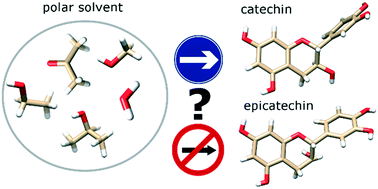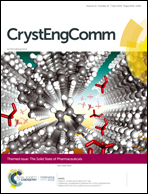Explaining crystallization preferences of two polyphenolic diastereoisomers by crystal structure prediction†
Abstract
Despite their structural similarity, two naturally occuring polyphenols, epicatechin and catechin, display significantly distinct crystallization behaviour. Epicatechin crystallizes only as a pure compound, and appears to be monomorphic, whereas no pure crystalline form of catechin is known, but it can form a variety of solvates with polar solvents. This work aims to explain these experimentally observed differences using the results of crystal structure prediction calculations. The entire conformational space of both molecules has been included in the crystal structure prediction study, which also explored the crystal structure landscapes of the pure crystals, 1 : 1 solvates and 2 : 1 solvates. From the computational results, we were able to show that the experimental observations with regard to crystallization behavior are the result of a trade-off between intra- and intermolecular energy contributions to the total energy of a crystalline system. In the case of epicatechin, conformers with low gas phase energies are at the same time the ones able to form crystal structures with favourable intermolecular interactions. In contrast, only high energy gas phase conformers of catechin were found to be able to pack efficiently. Consequently, the unfavorable intramolecular energy contribution has to be compensated by stabilizing intermolecular interactions. The calculations for 2 : 1 and 1 : 1 methanol solvates of both molecules demonstrate that such compensation can be readily provided by solvent molecules able to form hydrogen bonds with catechin.

- This article is part of the themed collection: The Solid State of Pharmaceuticals


 Please wait while we load your content...
Please wait while we load your content...